
Lead Generation Marketing: 100 Strategies, Ideas and Examples Part 6
76. Audience Referencing
People like to know that a lead generation offer or magnet is for them – so make it explicit.
The best way to do this is to test “Get your [lead magnet]” in your CTAs, but the theory behind this is based more with headlines…
In a study in Norway, researchers tried a variety of different headline styles on a shopping website:
- “For sale: Black iPhone4 16GB” (the regular headline)
- “Anyone need a new iPhone4?” (question headline without referencing cues)
- “Is this your new iPhone4?” (question headline with referencing cues).
They found that question headlines with audience-referencing cues (“Is this your new iPhone4?”) generated higher click-throughs than other types of headlines.

To learn more, check out 8 Winning Headline Strategies and the Psychology Behind Them from Buffer.
Use The Five Most Persuasive Words
77. Your Name
A 2006 study found that “hearing one’s own name has unique brain functioning activation specific to one’s own name.”
It used to be that “You” was the #1 “most persuasive word” in these kinds of lists, but that was before we could personalize as we can now.
No, when generating leads you, by definition, won’t have your visitor’s name. But you could have their location, or their business name.
Software (like Wishpond’s integration with Clearbit) allow you to dynamically insert information mined from a visitor’s IP address. This allows you to change your landing page’s headline to “Get the Lead Generation Tools to Take [Company Name] to 10,000 New Leads.”
And if the integration isn’t sure of the visitor’s location or company, code in the landing page will simply revert to “Get the Lead Generation Tools to Take Your Company to 10,000 New Leads.”
78. Free
Lindor is a better chocolate than Hershey’s kisses. If you disagree with me you’re welcome to your wrong opinion, but let’s move on.
If I offered you a Hershey’s kiss for a cent vs a lindor chocolate for 15 cents, which would you take?
In Dan Ariely’s book Predictably Irrational, he reports the following:

When offered Lindor (far better chocolate) for only 15 cents, 73% of those studied said yes vs 27% who preferred the Kiss.
However, when the price was reduced by a single cent (meaning the Kiss became free), the results were flipped:

As Gregory Ciotti writes it, “Although in the first test it appears we simply can’t pass up a deal, as it turns out, we really can’t pass up a steal.”
Free is the ultimate value proposition. The “ROI” of something free is infinite.
79. Because
In Robert Cialdini’s famous behavioral psychology book, Influence, he cites a study in which test subjects were asked their response to a request from a person in a hurry to cut in line to use a copy machine.
The first test had the person in a rush say, “Excuse me, I have 5 pages. May I use the Xerox machine?”
Around 60% of people allowed them to cut.
The next test had the person in a rush say, “I have 5 pages. May I use the Xerox machine, because I am in a rush?”
Pretty damn subtle.
And yet, 94% of people allowed him to cut in line.
“Because” gives us a reason, even if it’s a poor one. Compared to no reason whatsoever, anything is better.
A few examples for lead generation:
- These 10 email marketing subject line formulas will boost your responses. Because aren’t you tired of miserable open rates?
- Because none of us have time to email every lead, Wishpond’s excited to announce our new automated lead nurturing software!
- Subscribe to the Wishpond blog. [Implied Because] 10,000 other marketers already have!
80. Instantly
Brain scan Studies have shown that when we anticipate an instant reward, our mid-brain is activated (a good thing).
For software companies offering gated lead magnets or free trials, that’s a good thing. “Instant access” is easily attainable. As is “Get your ebook NOW” or “Sign up in just 25 seconds.”

But, for every industry, it’s important to remember that it’s not just because people are busy that you want to mention that your support team will get back to them ASAP – it also triggers the brain.
81. New
Medical studies have shown that exposure to something new and unfamiliar stimulates a region in our brain which is responsible for regulating motivation and reward-processing.
In short, when you expose your prospective customers to a new idea, technology, or approach, they’re wired to become intrigued.
And yet, don’t go overboard. If something’s not broken, don’t fix it (your support team, the relationships you’ve built with previous customers, etc). But your products? Yes, update those as often as feasible and be sure everyone knows about it. If you want to stay on the cusp of what’s possible and what’s awesome, you need to innovate.
To learn more about these 5 persuasive words, check out CopyBlogger’s “The 5 Most Persuasive Words in the English Language,” and “The Ultimate Guide to Conversion Rate Optimization: Chapter 4: The Right Copy“
Phrases that imply exclusivity
82. Members Only
Everyone wants to be part of an exclusive club.
Here’s an example of an “exclusive membership” from Jon Loomer’s “Power Hitters Club”:
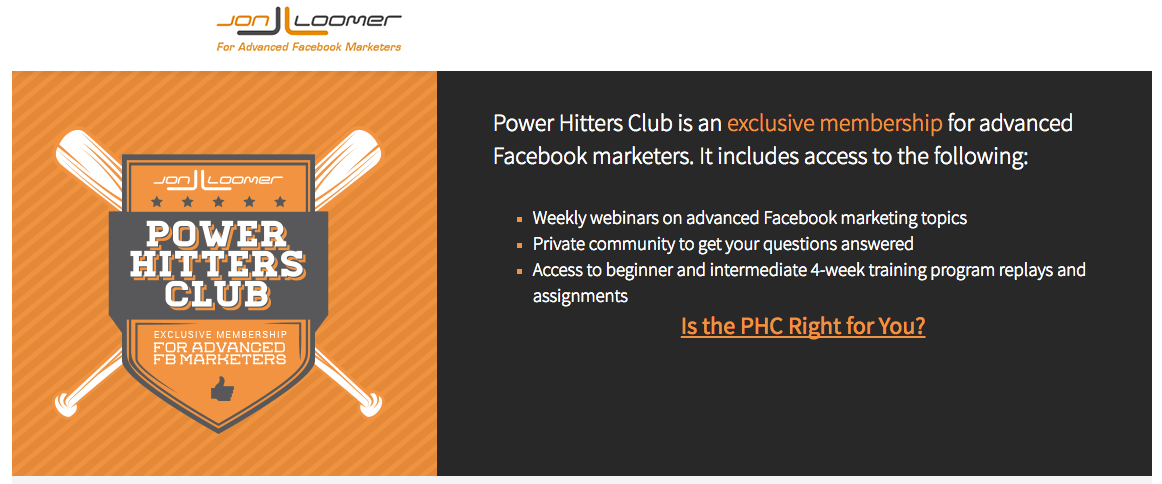
83. Ask for an invitation
Many social communities utilize the “ask for invitation” strategy to A) control the number and quality of members and B) to subjectively increase the value of being in that community.
“Invite-only” communicates both the quality of the people within the club (are awesome enough that new people have to apply to hang out with them) and gives the applicant a sense of self-worth when they’re accepted.
84. Apply to be one of our members
The difference between “ask for” and “apply to be” is a strengthened possibility of not getting. This is a powerful way to communicate value. If there’s a perceived possibility that you won’t be received, even if you provide the lead information required, the value of entering becomes that much higher.
Don’t exhaust this, of course, but instead communicate subtly the possibility that a course, for instance, is limiting the number of entrants for this quarter and you’re selecting only so many.
85. Become an insider
Jon’s “Power Hitter’s Club” strategy is also an effective way to communicate the idea of its members as “insiders” – as it’s only for “advanced facebook marketers.”
Insiders get to look out at the rest of the world and feel superior. You’re part of a club, a clique. And if you think that all these things stopped mattering when you graduated high school, you’d be wrong.
Just try it and see the results you get.
86. Get it before everybody else
This is straightforward newsletter subscription stuff. “Get it before anyone else” taps into that “novelty” psychological factor I mentioned in Lead Generation Marketing Idea #81.
New = better. New increases the subjective value of something, even if there is only a superficial change from old, or (and my grandfather would swear this to be the truth) if the new actually ends up being worse.
To learn more about words and phrases which communicate exclusivity, check out Buffer’s “189 Powerful Words That Convert: Write Copy That Gets Your Customer’s Attention Every Time.“
87. Cause-and-Effect Words
Author Darlene Price, the originator of the cause-and-effect theory of persuasive language has this to say about them: “Cause-and-effect words make your claims sound objective and rational rather than biased and subjective.”
Rather than your lead generation magnet being entitled “100 Growth Hacking Strategies That Work” try “100 Growth Hacking Strategies Which Resulted in 212% Growth Year-on-Year.”
To better convince your website traffic that you’re not just blowing smoke, your advice and educational content should be phrased in relation to a cause and effect. Here are a few words to do that:
- Accordingly
- As a result
- Because
- Caused by
- Consequently
- Due to
- For this reason
- Since
- Therefore
- Thus
To learn more, check out “Words And Phrases That Inspire, Motivate, And Persuade At Work” by Forbes writer Jacquelyn Smith.
88. Disrupt Then Reframe
A study was done by researchers to test the effect of disruption and reframing on some volunteers. They gave them a couple price options (very quickly) phrased like this:
- $3 for 8 cards
- 300 pennies for 8 cards… which is a bargain!
The second offer drove twice as many sales as the first, despite them being identically priced.
Here’s how DTR works:
- Disrupt your visitor’s thought process (dollars presented as pennies)
- While they’re in the middle of the disruption, Reframe (“Which is a bargain!”).
- Visitors won’t have time to fully internalize the information presented by the disruption so will act with their gut, which is responding to the information “this is a bargain”
To learn more, check out Strategy #1 within Bushra Azhar’s “The Quick and Dirty Guide to Turning Your Website into a Persuasion Powerhouse” on CopyHackers.
89. Label your Audience
How we’ve labelled ourselves (or how we’re labelled by others) seriously impacts our behavior. And again, this is one of those things that we act upon every single day of our lives without ever knowing we’re doing it.
A study from Harvard and Stanford found…
“The phrasing of survey items was varied to frame voting either as the enactment of a personal identity (e.g., “being a voter”) or as simply a behavior (e.g., “voting”).
As predicted, the personal-identity phrasing significantly increased interest in registering to vote and, in two statewide elections in the United States, voter turnout as assessed by official state records. These results provide evidence that people are continually managing their self-concepts, seeking to assume or affirm valued personal identities.”
Think about Jon Loomer (#81 above) referring consistently to the fact that his course is exclusively for “advanced Facebook marketers.” The first headline of his landing page’s copy is “This course is not for beginner Facebook marketers.”
Even if you are one, no one wants the negative label of “beginner.” Simply by labelling his prospective leads as “advanced’ and his unwanted leads as “beginner” he makes his offer more enticing.
To learn more, check out Strategy #15 within “The Ultimate Guide to Conversion Rate Optimization: Chapter 6: Tricking the Brain.”
90. Give Them A Challenge
Any “improvement”-focused lead magnet can and should work with challenge-based messaging.
People like a challenge, and they like progressing through it.
I recommend you combine your educational challenge/course with a series of automated emails, sent either daily or a few times a week with follow-up tips related to the progress each lead is making.
This way, you stay involved in their progress and they get more value out of you, consistently.
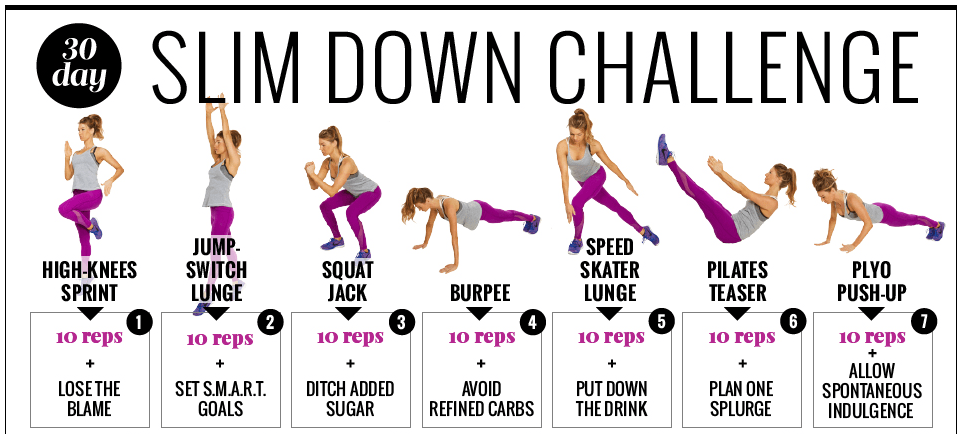
To see an example of this lead generation strategy, check out Shape’s “Lose Weight This Month with Our 30-Day Shape Slim Down Challenge.“
91. Refer-a-friend Competition
Refer-a-friend promotions work by incentivizing sharing.
It means that your promotion’s entrants are working with you to promote. There’s a couple options:
- Give users additional entries for sharing your promotion, thereby increasing their chance to win.
- Give users additional entries for getting their friends to enter as well (through an entrant-specific share URL).
Both are powerful ways to get your target market to share with their friends, who are, in turn, incentivized to share with their friends, and on and on.
We’ve had referral promotions drive 10,000+ entries. They can grow exponentially.

It’s essential that you remember to create a promotion/set a prize which is only appealing to your target market – particularly with a referral promotion. You don’t want to generate leads who are just entering to win your unrelated prize (cash, an iPad, etc). Think about a year’s subscription to your platform, a giftcard (if you’re B2C) or a package of your products.
To learn more, check out “How to Use a Fan-Only Promotion to Turn Followers into Leads.”
92. User-Generated Content Contest
UGC is “any data or media that is contributed by individual users of a website.”
In the context of a contest (say that 10 times fast) we’re talking about people submitting an original piece of content in an effort to win your prize.
The cool part, for lead generation marketing, is that the winner isn’t determined by which one you think is best. It’s determined by which of the entries has the most votes.
This means that each entrant is incentivized to share the hell out of their entry. To win, they’ll promote it on every social media platform they have and encourage their friends, family and colleagues to vote for their entry.

To learn more, check out “User-Generated Content: How to Get It and Why You Should.
93. Free Expert Review
Position yourself as the expert in your industry and offer a free review of your prospective customer’s strategy.
A few things to review:
- A startup’s landing page or homepage
- A dieter’s meal plan
- A family’s budget
- Someone’s wardrobe
- A lead-nurturing email campaign
This is also an excellent time to use the questionnaire-type lead generation form, where you learn more about your leads than you otherwise could with a simple email gate.
94. Retargeting
I don’t recommend using PPC ads to drive lead generation, as it’s unlikely you’ll be able to get a positive ROI out of it.
What I do recommend is a retargeting/remarketing campaign. Test Facebook Ads vs Adwords to see which gives you the best return.
We’ve found success retargeting visitors to our Instagram blog articles with a Facebook Ad promoting our Complete Guide to Instagram Marketing ebook. We’re paying about $3/lead and going strong:

To learn more, check out “3 Ways to Use Retargeting to Find Success Online.”
95. Don’t use stock photos
A company offering truck-driving classes wanted to optimize their homepage. They decided to test their image (which was a stock image).
They’d initially gone with the image which appears second in Google’s image search results when you type “man driving truck” into the search bar:

They tested this one:

And increased conversion rates by 161%.
Stock images aren’t trustworthy. They’re not real, and the people in them have no relation to what you’re selling. Every smile is unrelated. Every thumbs up has nothing to do with you.
A DSLR costs between $500 and $700. It’s well worth the investment.
To learn more, check out “Stock Photo or Real Image? A/B Testing Finds Out Which is Better” from VWO as well as “17 Landing Page Examples Reviewed with A/B Testing Ideas.”
96. Poll
People love expressing their opinions. A poll or vote – like “Which of these two landing pages do you think converted better?” – is a great way to allow them to.
Gate the results of your poll and people will (as we’ve seen before) feel like they’ve invested in the process and be more likely to convert.
Here’s an example from BEHAVE.org (formerly WhichTestWon), where they ask visitors “how good is your gut?”:
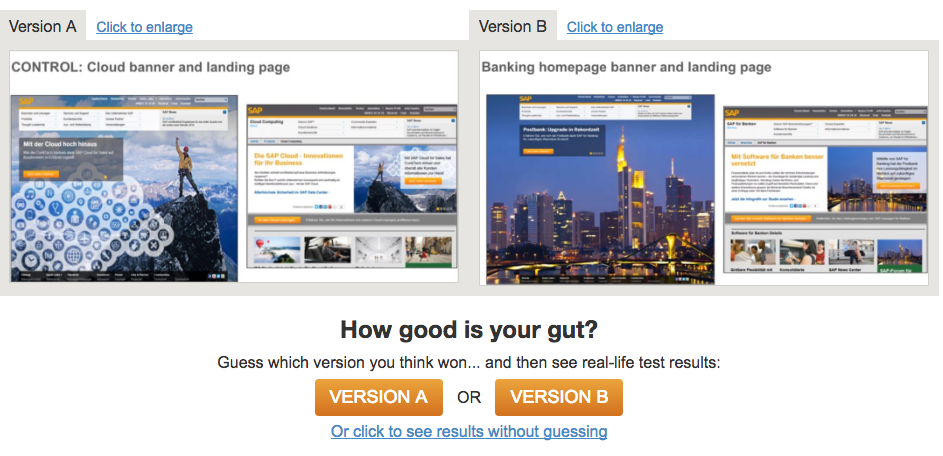
To see an example of a gated poll, check out BEHAVE.org’s Landing Page Case Studies. To see the email gate, just vote on which variation you think won.
97. Roundup Newsletter
Just because your business isn’t publishing content, or enough content to drive serious subscriber numbers, doesn’t mean you can’t send out an awesome newsletter on a weekly basis.
Hiten Shah has made it a business to collate the content he loves from each week and send it out to his subscribers:
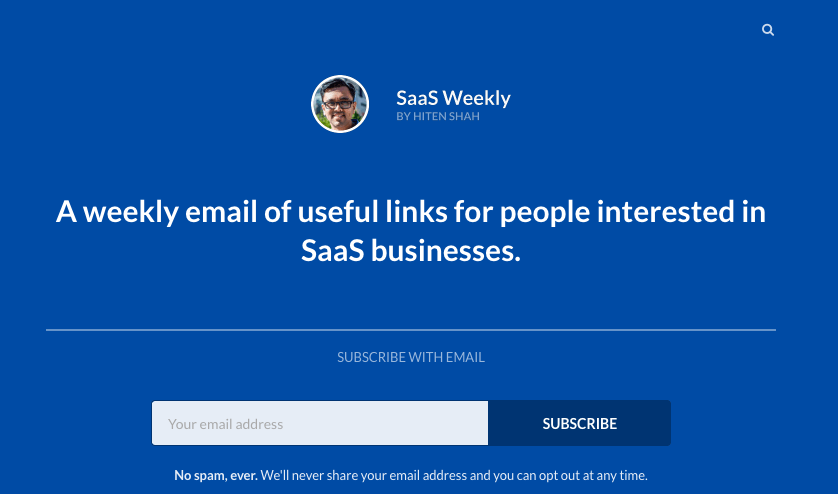
It’s not his content, but it’s his recommendations. And he’s respected enough that people subscribe based on the belief that he knows what they should read. And they’re not wrong.
You can do this as well. Content curation is a huge part of a successful inbound marketing strategy. If you’re doing it for social media (as you should be) simply expand the effort you put in. FInd the top news or thought-leading content published in your industry and bring it to your prospective customers in one place.
To see an example of a roundup newsletter landing page, check out SaaS Weekly, by Hiten Shah.
98. Use Quora to Get Lead Magnet Inspiration
Quora is a great place to see what people care about in your industry. Create our filters, see the questions, and watch the ones which is being followed the most. A highly followed question means that other people want the answer as well.
Any topic related to you business which has been followed by a lot of people on Quora is a good place to start when coming up with either content or lead magnet topics.

To learn more about using Quora, check out “How We Answer Quora Questions to Drive Traffic to Our Website.”
99. Validate your Content Ideas
This is also called “The Andrew Chen Technique.”
Essentially, Andrew Chen tests his lead generation magnets and content marketing ideas by first formulating a Tweet…
“Recently I’ve been running an experiment:
- Tweet an insight, idea, or quote
- See how many people retweet it
- If it catches, then write a blog post elaborating on the topic”
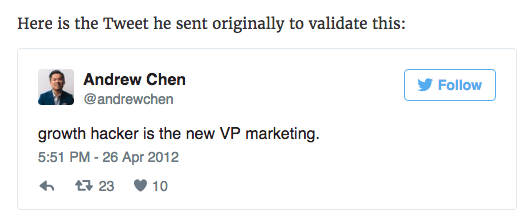
Pretty straightforward, but it’s a cool way to prove (or disprove) the popularity of an idea.
Another way to do this, though not with your prospective users, would be to engage in a content marketing Slack channel (learn more about how to drive traffic with Slack in my article “50 Ways to Drive Website Traffic”). Ask other content marketers what they think about a title or concept and see what their thoughts are. Would they want to read that article? Or has it already been done?
To learn more, check out Buffer’s “A Scientific Guide to Writing Great Headlines on Twitter, Facebook, and Your Blog“.
100. The Feature Box Technique
The Feature Box is a straightforward lead generation strategy, but few businesses have actually done it.
One of the organizations who has, actually, is Social Media Examiner (and they know exactly what they’re doing):
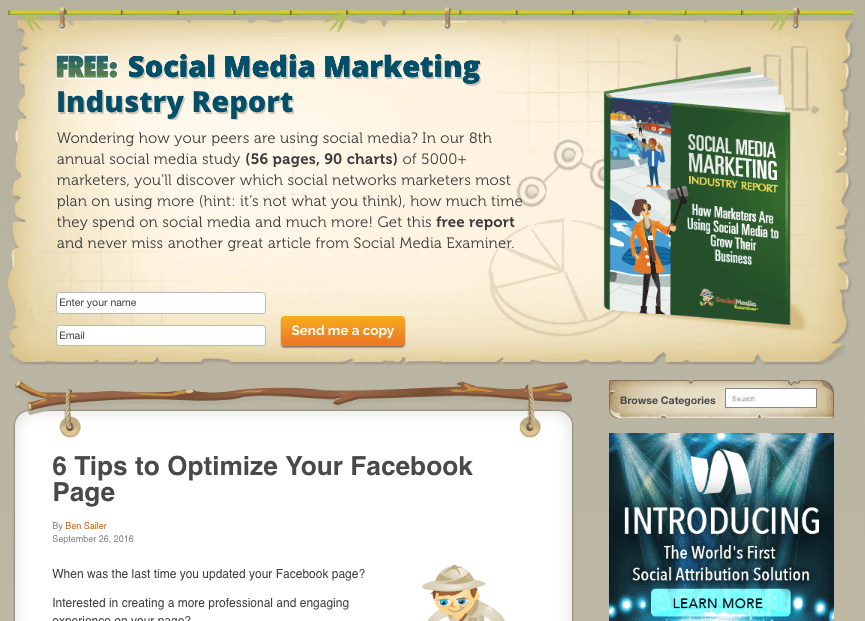
The “feature box” appears at the top of your blog directory, and is centered around a “featured” lead magnet – either something you’ve just published or something you know your target market will love.
The feature box is an excellent way to ensure that your readers see your gated content (particularly because the sidebar is notoriously useless, though you didn’t hear that from me…).
When Derek Halpern (of SocialTriggers) added a feature box to his Thesis blog on DIYThemes, “daily new subscribers to the Thesis blog shot up by 51.7%” overnight.
Not bad.
To learn more, check out Derek Halpern’s article “How The Feature Box Increased Our Blog Subscription Rate by 51.7%” on DIYThemes.

Wishpond’s 1000+ Lead Generation
Strategies, Ideas, Best Practices & Examples
Click below to download the most comprehensive collection of lead generation strategies and examples ever compiled. Completely free.